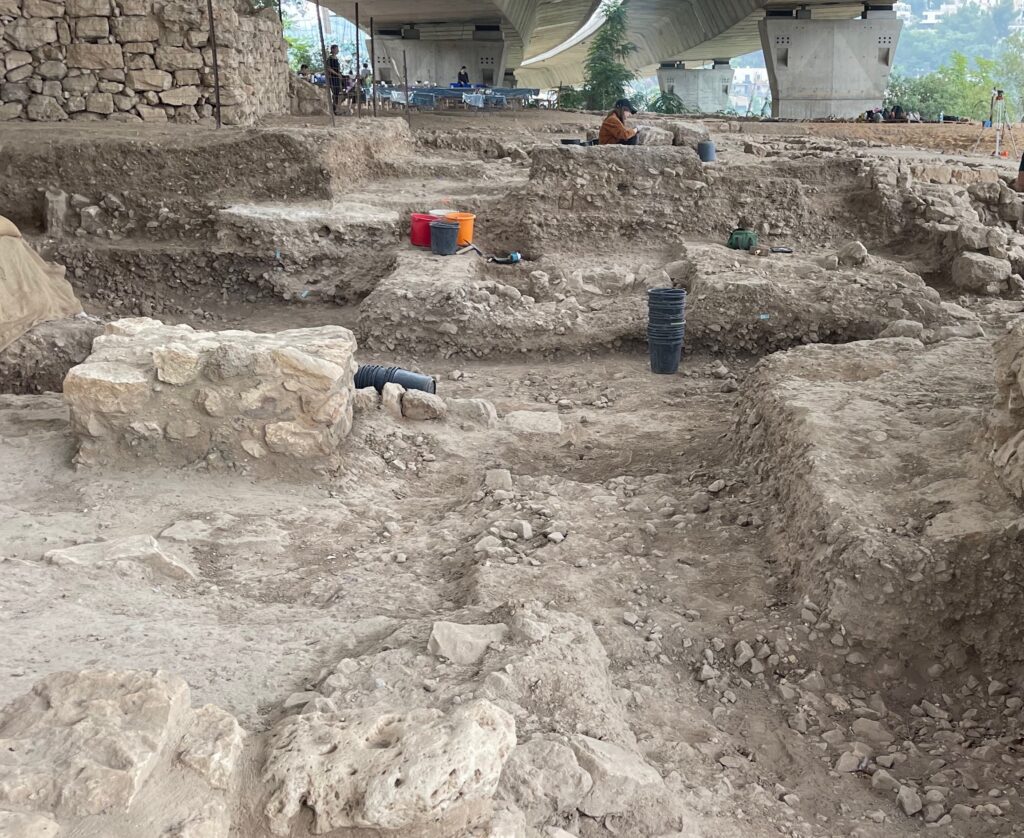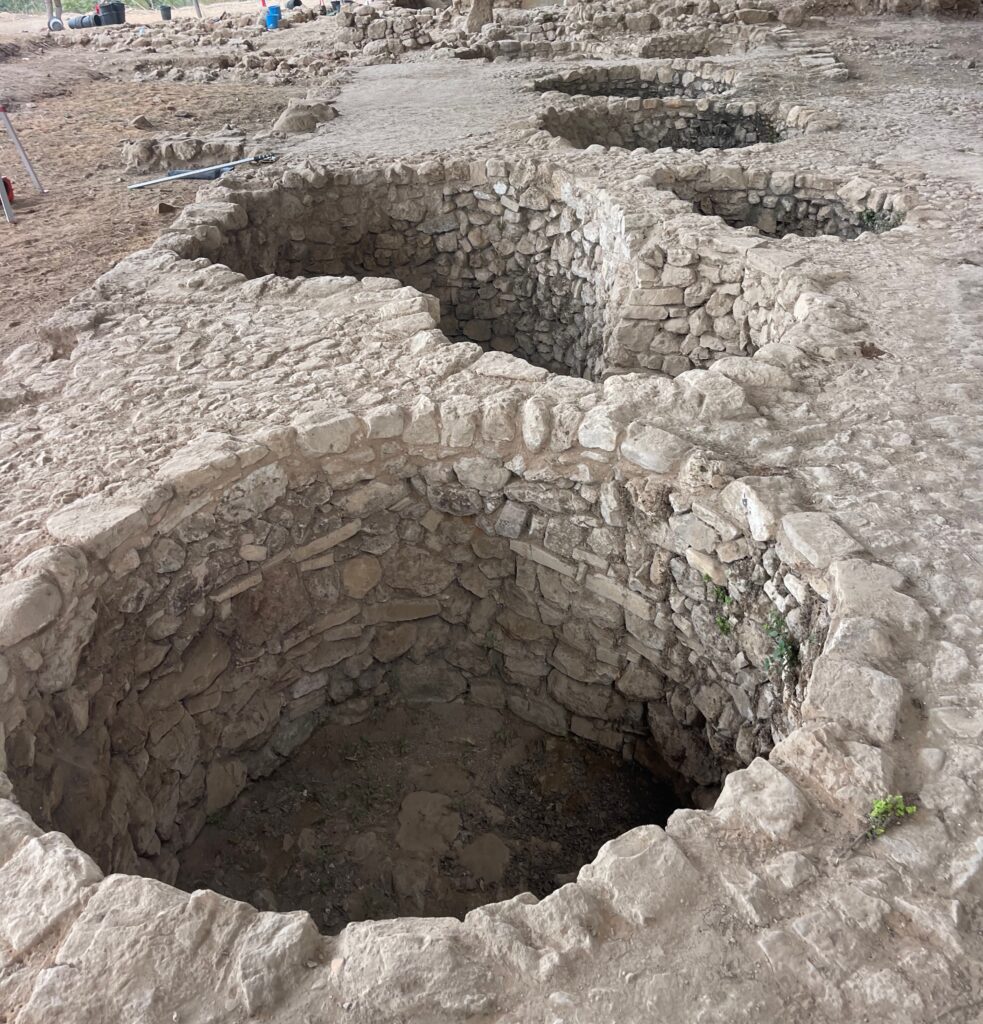Moza is mentioned in the bible as a city near Jerusalem, Kiryat Yaarim, Gibeon, and Kephira, in the territory of the tribe of Benjamin (Joshua 18:26). Today it is the modern name of the archaeological site identified with the biblical city “Khirbet Mizzah,” located 7 km north-west of the ancient city of Jerusalem. A unique temple from the days of the biblical Judean kingdom, which was probably active at the same time as the temple in Jerusalem, was discovered at the site. It is not mentioned in the bible, but it seems that this temple complex existed for a long time, underwent changes, and is the largest temple complex found in the territory of the Judean kingdom so far. There were many special artifacts found in and around it, including cult vessels, pendants, and figurines. Therefore, Tel Moza has much light to shed on the religion and cult in the Judean Kingdom during the Iron Age (10th–early 6th century BCE).

The name “Moza” is also mentioned in the book of 1 Chronicles as the name of characters in genealogies: Caleb ben Hezron’s son, a descendant of Judah (2:46); one of Benjamin’s descendants (8:36-37), part of Saul’s dynasty and of Benjamin’s tribe (9:42). Another mention of the name occurs in Mishnah Sukkah 4:5 as “a place below Jerusalem” where the “willow branches” that were placed at the side of the altar were gathered. Near the tel there used to exist the Arab village of Qaluniya, and the names “Colonia” and “Moza” are associated in the Babylonian Talmud: the Tanah calls “Kalaniah” (the Aramaic name of the village in the Talmud) “Mozah” (a way out/remedy) as this village was exempt from the king’s taxes (Babylonian Talmud, Sukkah 45a, Gemarah 2).
The Site and its Excavation
The meaning of the name Moza is “a source of water,” a name that suits the site’s location. It is situated on the southern slope of a spur at the foot of which the Sorek and Moza streams meet. The excavated area of the tel spreads across 3 dunams of terraces, 580-630 m. above sea level. The site was deserted during Israel’s War of Independence, and research there began due to construction on Route 1 which instigated two salvage excavations on behalf of the Israeli Antiquities Authority, funded by the road company of Israel: between 1993-2003, directed by Tzvi Greenhut and Alon De-Groot, and between 2012-2013, directed by Shua Kisilevitz, Anna Eirikh-Rose, Hamudi Khalaily, and Zvi Greenhut. In 2019 academic excavations were begun at the site, directed by Shua Kisilevitz and Oded Lipschits as a cooperative project of the Israeli Antiquities Authority and Tel Aviv University’s Institute of Archaeology.
The site’s location is unique, sitting next to the Sorek and Moza streams where there is seasonal water flow; there are springs and fertile soils in the area; and the site is high and overlooks its surroundings. These optimal conditions may explain the long sequence of occupation observed at the site: there were 16 settlement layers found, intermittently from the Pre-Pottery Neolithic B period (7th-8th millennium BCE) to the 20th century AD.

The Temple and the Settlement from the Judean Kingdom’s Period
There were four settlement layers found dating to the Iron Age. In the earliest one, dated to the Iron Age 1 and 2a (10th century BCE) there were various facilities and artifacts found which indicate activity at the site that probably ended in a fire. In the layer after it, dated to the Iron Age 2a (9th century BCE) the temple was found – a massive structure with columns, stairs, and pilasters at its entrance. Around its inner walls there were stone benches, and in it five medium-sized fieldstones and a scepter head made of Egyptian-blue pigment were found. Outside the structure a paved courtyard with different fixtures was discovered, among them one that was identified as an altar, that was situated in front of the building’s entrance. Next to it, a garbage pit filled with broken pottery, bones, and ash was found. Excavators found many broken pottery pieces around the building, some of them engraved, one of them with a rosette stamp. There were two broken inscriptions in ancient Hebrew script found (one of them containing the letters nss, which are understood to mean “the standard bearer”), as well as clay figurines, and it seems all these things were buried on purpose.
In the third layer, dated to the Iron Age 2b (8th century BCE) the temple underwent renovations and changes, and there were many silos, as well as a structure apparently used for agricultural produce storage built at the site. These were kept in use during the fourth layer of settlement, dated to the Iron Age 2b (7th-beginning of the 6th century BCE) during which the settlement expanded. It seems that the site was abandoned at the end of this period and was only resettled in the Hellenistic period (2nd century BCE), of which scattered evidence of activity was found. From the Late Roman period (3rd-4th century AD) there were finds discovered which indicate that the area was resettled, and the site was identified as the Roman village of Colonia. The village Qaluniya, which preserved the old Roman name, was established at the site during the Ottoman period and existed until 1948.
Sources
Greenhut, Z., & De-Groot, A. (2009). Salvage excavations at Tel Moza: The Bronze and Iron Age settlements and later occupations. Israel Antiquities Authority.
Khalaily, H., Re’em A., Vardi, J., & Milevski, I. (2020) Foreword: The Motza (Moẓa) excavations and beyond. In H. Khalaily, A. Re’em, J. Vardi, & I. Milevski (Eds.), The mega project at Motza (Moẓa): The Neolithic and later occupations up to the 20th century (pp. 9-18). Israel Antiquities Authority.
Kisilevitz, S. (2015). The Iron IIA Judahite temple at Tel Moza. Tel Aviv, 42(2), 147-164. Doi: 10.1179/0334435515Z.00000000052
Kisilevitz, S., Eirikh-Rose, A., Khalaily, H., & Greenhut, Z. (2014). Moẕa, Tel Moẕa. Hadashot Arkheologiyot: Excavations and Surveys in Israel, 126. https://www.hadashot-esi.org.il/report_detail_eng.aspx?id=10582&mag_id=121
Kisilevitz, S., & Lipschits, O. (2020). Tel Moza. Hadashot Arkheologiyot: Excavations and Surveys in Israel, 132. https://www.hadashot-esi.org.il/report_detail_eng.aspx?id=25702&mag_id=128
Mishnah Sukkah 4, The William Davidson digital edition of the Koren Noè Talmud, Sefaria website. Retrieved 27 April 2023. https://www.sefaria.org/Mishnah_Sukkah.4.5?ven=William_Davidson_Edition_-_English&lang=en
Sukkah 45a, The William Davidson difital edition of the Koren Noè Talmud, Sefaria website. Retrieved 27 April 2023. https://www.sefaria.org/Sukkah.45a?lang=en&with=About&lang2=en


